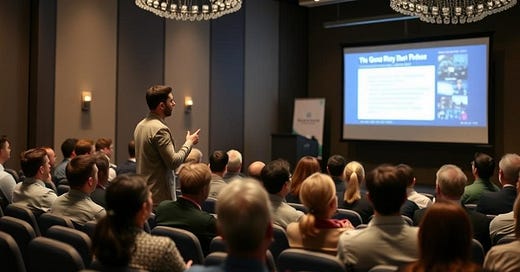7 Storytelling Secrets to Make Your Words Unforgettable
Transform your presentations, pitches, and content with these proven techniques.
Mitten Dad Minute is brought to you by:
Kortex been one of my favorite discoveries this year. It’s designed to consolidate your ideas, notes, highlights, and writing into a single, intuitive platform.
By integrating the best features from popular note-taking apps, Kortex streamlines your creative process, allowing you to focus on what truly matters—creating.
Excitingly, AI capabilities are on the horizon and will be included in the current pricing at no extra cost. This makes now the perfect time to upgrade before prices increase. Give it a try for free today!
Most communication is forgettable. Yours doesn’t have to be.
Why? Because the right story doesn’t just deliver information—it leaves a mark.
You know what I’m talking about:
You’ve spent hours crafting emails, pitches, or presentations, only to see your audience glaze over.
No follow-up questions. No excitement. No results.
It’s frustrating. And if this continues, you’ll miss opportunities, and your ideas will remain unheard.
But what if every time you spoke, people listened?
What if your words became stories they couldn’t forget?
What if your communication made them act?
Here’s how you can do it. These 7 storytelling secrets will help you:
• Frame your ideas like a hero’s journey to keep people hooked.
• Use emotional hooks to make your words resonate.
• Show instead of tell to create authenticity.
• Harness silence for maximum impact.
• Focus on relatable characters for connection.
• Craft strong openings and closings that stay with your audience.
• Use visuals that enhance your message.
Let’s dive in.

1. Frame Your Story as a Hero’s Journey
Every great story has a hero, a challenge, and a transformation. This structure is universally relatable—it’s how we process the world.
Most people skip the journey and go straight to results. The problem? Your audience doesn’t connect with the outcome unless they understand the struggle behind it.
For example, instead of saying, “We increased sales by 25%,” say, “We faced declining engagement, revamped our strategy, and boosted sales by 25% in just six months.” The journey creates a connection.
Action Step: Think of a recent success and outline it as a hero’s journey: the challenge, the actions taken, and the results. Use this for your next meeting or presentation.
(I recently wrote about how improvisation can help in the workplace and content creation. Improvisation teaches you to adapt, think quickly, and connect authentically—skills that pair perfectly with storytelling.)
2. Use Emotional Hooks
People remember feelings, not facts. That’s why stories with emotion stick.
Instead of leading with dry data, try this: “Our team struggled to keep up with demand three months ago. Then we made one simple change, and everything shifted.”
An emotional hook draws your audience in and keeps them engaged. They’ll feel invested in your message.
Action Step: Identify one emotional story related to your message. Practice delivering it in two to three sentences for your next presentation or email.
3. Show, Don’t Tell
Telling your audience what to think is a shortcut that doesn’t work. Showing them is far more powerful.
For example, instead of saying, “Our new software is easy to use,” show the results: “One of our customers cut their project time in half using our intuitive features.”
Action Step: Take a look at a recent report, email, or presentation. Replace one vague statement with a detailed example or case study.
4. Harness the Power of Silence
In storytelling, what you don’t say can be just as powerful as what you do. Pauses create anticipation and focus.
Most people rush through their points, leaving no time for their audience to absorb the message. Instead, pause before delivering a key insight. Let the silence amplify your words.
Action Step: Before your next meeting or call, practice pausing for 2-3 seconds before critical points. See how it changes the energy in the room.
5. Focus on Relatable Characters
We connect with people, not concepts. That’s why every story needs a relatable character.
Instead of saying, “Our product improved customer satisfaction,” share the story of a specific customer: “Meet Sarah. She struggled with X until she used our solution. Within a month, her satisfaction scores doubled.”
Action Step: Choose one “character” for your next communication—a client, a team member, or yourself. Make them the focus of your story.
6. Craft Strong Openings and Closings
First impressions matter. Lasting impressions matter even more.
Your opening should grab attention: “Today, I’ll show you how we solved X problem and saved $500,000.” Your closing should reinforce your message:
“This isn’t just about savings. It’s about setting a new standard for what’s possible.”
Action Step: For your next pitch or email, write an opening sentence that sparks curiosity and a closing that leaves no room for doubt.
7. Use Visuals That Enhance Your Story

Visuals make your message stick. But only if they support your story.
For example, a graph showing year-over-year growth is more impactful than a slide with dense text. Use visuals to clarify, not complicate.
Action Step: Add one visual element—a graph, photo, or illustration—to your next piece of communication. Make sure it highlights your key point.
Finale
Storytelling is your secret weapon.
It’s how you make your audience care. It’s how you inspire action. And it’s how you leave a mark long after the meeting ends.
Which of these techniques will you try first? Would you like to learn more about applying theatrical and communication skills to your everyday life? Let me know—I’d love to hear from you.
Your words can make a difference. Let’s make them unforgettable.







Your article is the blueprint for better speeches in public. Since I speak a lot in public on events I'm used to observing the reactions of the audience. And your article is exactly what you need.
The better the hook, the better the story the more your listeners are with you.
Thanks for a great read.
Great tips put together in such a clear and actionable way.